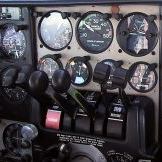 At the start of the week, five flyers were taken to the hospital after sudden turbulence struck a United Airlines flight from Denver to Billings, Montana. Then, on Wednesday, nine people were injured in severe turbulence on a Cathay Pacific Flight from San Francisco to Hong Kong.
At the start of the week, five flyers were taken to the hospital after sudden turbulence struck a United Airlines flight from Denver to Billings, Montana. Then, on Wednesday, nine people were injured in severe turbulence on a Cathay Pacific Flight from San Francisco to Hong Kong.
One study suggests instances of extreme turbulence might be increasing, but do flyers need to be afraid? Probably, not. The fact is, there have been six incidents with fatalities caused by turbulence since 1980. All were a direct effect of people not being buckled into their seats when the plane hit hazardous weather conditions.
Some turbulence is common and almost natural. It occurs when an aircraft is going through a strong wind current. Essentially, a mass of air meets another mass of air moving at a different speed. Passengers feel the plane jostle and jolt, but it is just seeking out the smoothest altitude. It may feel as though the plane dropped 100 feet, but it usually never drops more than 50 feet. Translation: Turbulence is a scary feeling but it does not mean the plane will go down.
Stay buckled up and informed! Here are 10 facts about turbulence that will keep you from clutching your armrest when things get bumpy on your flight.
When Turbulence Happens
- If you are flying during a storm or extremely cloudy weather, then your chances of flying through some turbulence is high. Storms and cloudy weather can create different air pressure, which creates winds moving in different directions,leading to turbulence.
- However, it does not always matter what the weather appears to be. A flyer may assume that because it is sunny out, the chances of turbulence are unlikely. Actually, calm winds during sunny days can create thermals, which are bubbles of warm air or rising air currents. This can cause light turbulence or later lead to afternoon thunderstorms, which will definitely lead to some turbulence.
What Pilots Do When Turbulence Hits
- Pilots are able to avoid extreme turbulence by following weather patterns. However, turbulence still hits during warm sunny days, so some turbulence is unpredictable. Pilots are trained to not fly directly into the turbulence. Instead, they aim to take the smoothest route or go around. However, turbulence can be over 100 miles wide and long, so some disturbances are unavoidable.
- A pilot is trained to slow the plane down to the turbulence penetration speed, which is known as maneuvering speed.
How Technology Helps Make Turbulence Better
- If you are flying in a smaller aircraft, expect to feel the turbulence more than you would in a larger aircraft, due to the weight and size difference. It is similar to taking out a smaller boat and hitting large waves versus a yacht or cruise ship going over those same waves—on a larger boat, you would not feel it as much.
- The FAA mandates that all commercial aircraft be built to withstand far more stress than they would ever encounter during rough turbulence. Over the years, aircraft are built to handle extreme turbulence. An aircraft could go through rough turbulence and get damaged on the outside, but the aircraft itself can withstand the intensity.
- Before the flight takes off, the pilots are given a PIREP, which is a pilot report. In the report, there are preflight plans, latest reports of turbulence from airborne aircraft, and accurate forecasts with areas of expected turbulence from satellites and meteorology technologies.
- Pilots also rely on the LIDAR (Light Detection and Ranging), which is located under the front of the aircraft. The LIDAR is made up of radars and lasers that detect how fast dust particles are moving. The light and radar tells the pilots if there is turbulence as little as 6 miles ahead, which is still enough time for a pilot to prepare.
Turbulence Is Predictable
- If you fly over a mountain, you should expect some turbulence because there is mountain wind that blows right over the ridges. The wind generally creates up and downdrafts, which causes different wind currents going against each other, making it a bumpy ride for aircraft and passengers.
- When flying through a jet stream, expect some turbulence due to the fast moving air currents. Depending on the speed of the jet stream, there may be minor or major turbulence.
For more information on turbulence, don’t miss:
By Siena Mazero for PeterGreenberg.com












